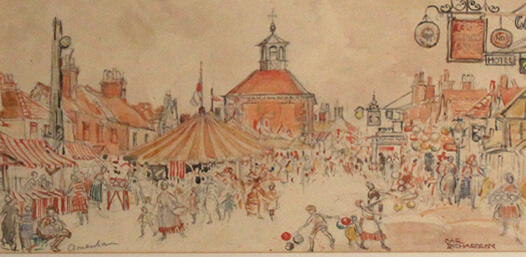The Richardson Sisters and the Tithe Barn
This page was written by Alison Bailey, with help from Richardson family members: Tony Voss, Alison Naisby and Rosie Hunt-Marciniak.
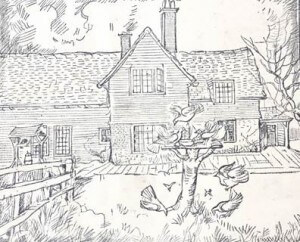
The Richardson sisters, Josephine, Caroline “Car” and Mona were born into a military family and were well travelled before settling in Chesham Bois in their middle years. After initially using Amersham as a weekend escape from London they settled in Chesham Bois for the rest of their lives, becoming actively involved in their new community. All had a major impact on the life of the village.

The sisters first came out to Amersham around 1906. According to one of Josephine’s obituaries, she first came out from London “seeking rest at weekends. And also in order to have leisure for writing and research”. After marrying in 1909, Mona and her husband Edward Voss built Ridge House, in Quill Hall Lane, Amersham, and their daughter, Elizabeth was born there in 1910. When Car and Josephine visited they initially stayed opposite in a chalet known as the Woodhouse (now a substantial property) but soon started to invest in the area themselves buying Lavender Cottage on Chestnut Lane and Hedge Row on Quill Hall Lane. In the 1911 Census all three sisters are living at Lavender Cottage, Chestnut Lane with baby Elizabeth. Josephine is head of the household and her occupation is given as a lecturer in literature. At that time Edward was away in Canada.

The sisters were the granddaughters of Sir John Richardson, the naval surgeon, Arctic explorer and naturalist. Their parents, Willingham Franklin Richardson and Elizabeth Blew Pym met and married in South Africa in 1867 where he was serving as an officer in the Royal Engineers in the British Army. Josephine was born in Cape Town in 1869 and the family then moved to India where Caroline was born in Chakrata, a hill station in the North West Provinces of India in 1873. The girls’ earliest memories were of an Indian garden on the slopes of the Himalayas. To this they attributed their intense life-long love of flowers.
Willingham’s older brother, Major-General John Booth Richardson, had a distinguished military career in the Royal Artillery in the West Indies, Burma, India and Gibralter. He created a portfolio of over 80 watercolours on his travels and became a renowned wood carver so artistic talent and a sense of adventure definitely ran in the family. One of John’s watercolours depicted Willingham’s grave after he too was stationed in India in 1882. Car’s portrait of her uncle, John Booth Richardson was hung in his officers’ mess in Shoeburyness after his retirement. She received a letter thanking her for the “excellent portrait, with our very best thanks for having enabled the officers here to possess such a good likeness of their late Chief”.
Tragically Willingham died of an aneurysm in 1875 and their widowed and pregnant mother returned to Britain with her young family, giving birth to Mona in Rockferry, Cheshire. After settling in Fulham, where their mother initially worked as an accountant, the three girls were sent to board at the Royal School for Daughters of Officers in Bath. The sisters studied languages and literature on the Continent but whilst Josephine went to work in Japan, where she spent 3 years living with a wealthy Japanese family teaching English manners and customs, Car studied Art in Paris.

After studying Japanese art, Josephine returned to England with a valuable collection of prints, part of which is now in the British Museum. Josephine then established a school for the daughters of Members of Parliament in 18 Great College Street, Westminster which she ran for fifteen years. Her pupils included Winston Churchill’s daughter Diana and HH Asquith’s daughter, Violet.
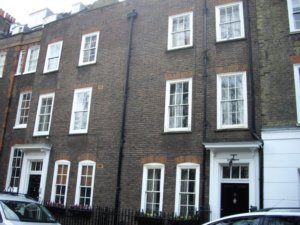
Car also returned to London and after their mother’s death in 1894 qualified as a teacher at the Royal Drawing Society of Great Britain and Ireland. She worked as an artist and teacher at a number of schools including Bromley High School and Josephine’s Westminster school, which was also their London home. Before her marriage, Mona worked as a sanitary inspector in Chelsea with responsibility for public health in the area. The adventurous sisters continued to travel, however and it was on one such journey that Mona and Edward met. According to Mona’s grandson Tony Voss “there was a story that I was told by my mother that the three sisters were on a train going somewhere through the Alps when suddenly Mona looked out of the window and said “I am going to climb that mountain” and she left her sisters on the train, she got out at the next station and she just climbed up the mountain and when she got to the top she met the man who would become my Grandfather, who had also climbed up. They met on the top of the mountain”.
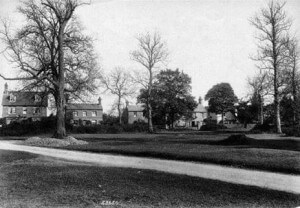
In 1915 Car purchased Downash (the old school house) in Bois Lane, Chesham Bois from Dr Mott. She also bought Rose Cottage further up the road. Apparently she had spotted Downash from a bus and had no idea that it also came with a substantial field (what remained of Grey Leaze Field) containing a dilapidated barn. It was this derelict barn, later named The Tithe Barn, which was to become Car and Josephine’s home for the rest of their lives, letting out their other properties, often to family members.
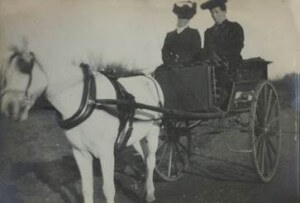
The barn was reputed to have been relocated from an orchard in the Old Rectory in Amersham and the 1st Chesham Bois Scout Troop had been using it for some of their meetings since their formation in 1908. Car extended and renovated it to provide living accommodation and an artist’s studio. At the south end was a substantial stable for up to three ponies and space for a stable lad to live in the loft above, which was accessed by a ladder on the wall. Car kept a pony there for a long time and the sisters were often seen around the village, or setting off for a picnic in the pony and trap, accompanied by their dogs. Mona’s granddaughter, Alison remembers visiting Car’s great friend Mrs Tyrwhitt-Drake at Shardeloes in the trap as a child. The loft above the stable was later integrated into the house and a staircase was added. Car’s companion, Lizzie Buckingham lived there in later years.
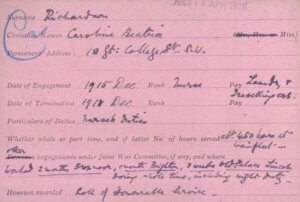
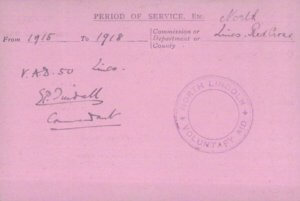
For some time Mona lived in Canada where her husband was prospecting and where he had various jobs including working as an analytical chemist. Their son, John was born in Calgary in 1915. According to John’s daughter Alison Naisby “He was born in a hut in the back woods. They had a couple of dustbins outside and of course they would have a lot of tinned food because the ground was frozen and there would be very, very long cold winters. They used to throw out the tins into the dustbins, and the bears would come round at night and forage through the dustbins to find the syrup tins so they could lick them out. Instead of having a pram my Grandmother had a sledge and she would put John in a box, a wooden box, and she would put it on the sledge with her skates on and instead of taking him for a walk she would skate down the river near their wooden hut and take him out for rides on the sledge.”
The family returned to England and settled in Rose Cottage before moving to Sloe Cottage in 1929 when Car bought it, and later to their own house, Ridgecroft, in Berkhamsted. However Edward continued to travel extensively with his work to Canada, Burma and elsewhere with Mona joining him as soon as John and Elizabeth could go to boarding school. During the holidays the children would often be sent to various relatives when Mona and Edward were away. Their favourite holiday destination was home to Chesham Bois because Josephine and Car “were warm and interested in everyone and really loved children” according to Alison. After Edward’s death in Berkhamsted in 1939, Mona returned to Amersham and lived in Cranbourne in Chestnut Lane for the rest of her life.
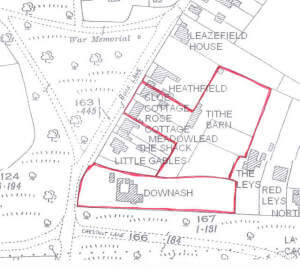
The Tithe Barn, and its lovely garden, became the centre of many activities and social gatherings for the village. When the garden was looking particularly pretty in spring with wonderful displays of snowdrops or daffodils, Car or Josephine would put a sign at the top of the drive inviting people to come down and view them. Having been an orchard, the garden was full of wonderful cherry trees which inspired many of Car’s paintings when they were in blossom. When the cherries were ripening a bell was hung there to warn the birds off. Tony remembers “Outside the kitchen there was a back porch where the galoshes were stored for going out in the garden and it was from there that the string to the bell out in the cherry trees was and it was her [Lizzie’s] job every few minutes during the cherry season to go out to the back door and pull the string where that bell would ring and all the birds would fly out of the cherry trees.”
Alison continues “And so particularly when the cherry season was in, we were all round there and it was a great orchard for black cherries which were really beautiful and very sweet. She would have cherry collection, gathering parties and invite friends and neighbours to come along and pick the cherries and all sit down and have a cup of tea and we would all stuff ourselves with these beautiful sweet cherries and she would get Lizzie, who was her companion, to make cherry jam from these cherries. She also had in her garden a wonderful old quince tree and it was a bit dilapidated so some of the branches were propped up on a couple of poles and again she loved the quince tree because it was a beautiful shape and she would put it in one or two of her paintings”.
There was a large shed in the garden, full of interesting trunks and cases from their travels, an apple store, a well and a large herb garden at the front of the barn as according to Alison, Car was particularly good at growing herbs, especially fennel. They cooked with the herbs and used them medicinally in tinctures. However the vegetable patch was very much the domain of their gardener, always known as Buttercup, who Car immortalised in a lovely portrait with his cap and pipe.

Both Alison and Tony have many memories of Buttercup, scything the grass and watering his vegetables with a water bowser which he would fill up with water from the well. They both particularly remember him taking his afternoon nap. Tony: “I can remember too that Buttercup had a habit of going to the Boot and Slipper at lunchtime for a pint of cider and he would come back in the afternoon a little drowsy and he would lie back in a wheelbarrow. And he would drift off to sleep and the bees would come and sort of visit his beard hunting for any traces of cider and I do remember quite clearly Aunty Car saying to me “Don’t disturb Buttercup”. So he would sleep the afternoon away having come from the Boot and Slipper, laid out in his wheelbarrow.”
Alison: “He would chat to us but he was very elderly, particularly at the end. I don’t think he did very much work. The vegetable garden went pretty much into decline, let us put it like that, but they kept him on. They were loyal, they were loyal to Buttercup and to Lizzie. As long as he was moving they kept him on.”
Both sisters were very active in village life. They were early members of the Chiltern Arts and Handicrafts Club, founded by artist Louise Jopling, who they greatly admired, in 1919. They held the first major art exhibition for the society at the newly restored barn and were involved in every aspect of the Club. Both sisters gave lectures on their particular interests with Josephine regularly lecturing on Japanese Prints. Josephine was elected President of the Club in 1941 and held the post until her death in 1945 and Caroline was elected President in 1955 until her death in 1959. Josephine became the second woman to be elected to the Parish Council in 1934 and Caroline also later became a Parish Councillor.
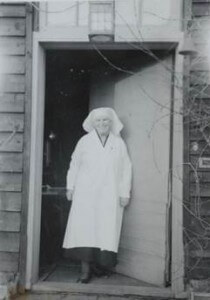
Both sisters were very involved in the Red Cross, particularly during the World Wars with working parties and meetings held in the Tithe Barn. Car painted one such working group (probably during WWII) rolling bandages dressed in Red Cross uniforms and splendid head-dresses. Car qualified in First Aid at the College of Ambulance and Home Nursing at the British Red Cross Polytechnic in 1916. Her WWI service record shows that she worked as a nurse in hospitals in Wainfleet, Lincoln, Brighton and Boxmoor. Her only pay is listed as ‘laundry and travelling expenses’.

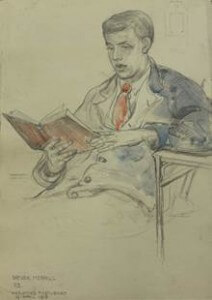
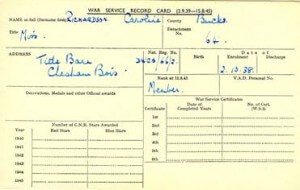
 Whilst working as a nurse she sketched over 100 poignant drawings of convalescent soldiers in their Red Cross blue suits and red ties (they were supposed to wear these so that they would be easily recognised and presumably stopped from spending all their time down the local pub!). During WWII she worked in occupational therapy and when Queen Elizabeth visited the area in 1941 she met both Josephine and Car in recognition of their work for the Red Cross.
Whilst working as a nurse she sketched over 100 poignant drawings of convalescent soldiers in their Red Cross blue suits and red ties (they were supposed to wear these so that they would be easily recognised and presumably stopped from spending all their time down the local pub!). During WWII she worked in occupational therapy and when Queen Elizabeth visited the area in 1941 she met both Josephine and Car in recognition of their work for the Red Cross.
In addition to her beloved pony and cart, Car also learnt to drive and appears in the Lincoln, Rutland and Stamford Gazette Mercury of Friday August 16th 1935 after pleading guilty to failing to conform to traffic signals and to not having a driving license for a car! She was fined 10s. Alison remembers her being stopped when driving in Aylesbury by a young policeman because she was going the wrong way down a newly installed one-way scheme. “Young man” this formidable lady exclaimed “I have been driving this way down here for years and I don’t intend to stop now!”
Apart from their earliest years in India, Car and Josephine always lived in households run by strong women. As pioneers of women’s education, they taught the daughters of the Establishment, and it is rather delightful to think they helped shape Churchill’s daughter, Diana’s views on issues such as Women’s Suffrage. Let’s hope she supported her mother, Clemmie Churchill (a known suffragist) when the topic was discussed around the breakfast table. As Churchill was often a target for Suffragette anger and had famously written that “I am certainly not going to be henpecked into a position on which my mind is not fully prepared” you can imagine that there would have been some lively debate.
Their friend and neighbour in Chesham Bois, the artist Louise Jopling was a suffrage campaigner, a member of the Tax Resistance Group and the Suffrage Atelier and had painted many banners for the Artists League. The secretary of the Chiltern Club of Arts from 1928 to 1936, Margaret Wright was a Suffragette and the museum has an article written by her about her militant days. The sisters were members of a number of societies concerned with improving women’s education and their position in society, such as the Soroptimist Club of Greater London and women’s Freemasonry.
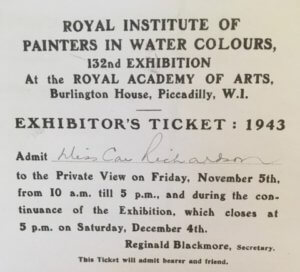 Car continued to paint prolifically after moving to Amersham. She was often inspired by the Buckinghamshire countryside around her and particularly by her own garden with its picturesque well and lovely cherry trees. Car exhibited and sold her charming paintings widely. As well as local exhibitions, her work was regularly exhibited in London at the New English Art Club and at the Royal Academy for the Royal Society of British Artists and the Royal Institute of painters in Water Colours. Car was also a talented illustrator often using wood-engraving to create Christmas cards of London scenes and detailed images of the garden and well at Chesham Bois. She also created a number of book illustrations although it is not known if these were published.
Car continued to paint prolifically after moving to Amersham. She was often inspired by the Buckinghamshire countryside around her and particularly by her own garden with its picturesque well and lovely cherry trees. Car exhibited and sold her charming paintings widely. As well as local exhibitions, her work was regularly exhibited in London at the New English Art Club and at the Royal Academy for the Royal Society of British Artists and the Royal Institute of painters in Water Colours. Car was also a talented illustrator often using wood-engraving to create Christmas cards of London scenes and detailed images of the garden and well at Chesham Bois. She also created a number of book illustrations although it is not known if these were published.
Car painted many London scenes, including historic events when the capital was bedecked with flags such as the 1919 Victory Parade. She also painted and exhibited in Lincolnshire where she had family and during extended travels abroad. She painted many of Buckinghamshire’s beauty spots and in the run up to WWII, as part of a national appeal, she was commissioned by the Bucks Archaeologists Society to make drawings of buildings of historical interest threatened with destruction which are preserved in Aylesbury Museum. These include some lovely watercolours of Old Amersham High Street and Chesham. She was also commissioned to make drawings of windmills, supposedly by the Ministry of Defense, during WWII and the family have an enormous collection of these from all over the country. Her paintings of Old Amersham, especially of Amersham Fair are packed with vivacity and life. To quote Tony “she later evolved a distinctive lighter sketchy style using pencil and wash on cream paper. She often included figures going about their activities – sometime just an outline or allusion to the person. These are particularly effective in her depictions of town fairs and markets”.
June 19th 1959, Car died at the age of 85 in Chesham Cottage Hospital. She is buried in Chesham Bois Burial Ground with her sister Josephine. Lizzie Buckingham later joined them in the neighbouring plot. Car left an incredible legacy of paintings and drawings still treasured by her family and which we are very privileged to be able to enjoy today.
Click here to see a large collection of pictures by Caroline Richardson.

